【QML-容器】
Qt编程指南-VX:hao541022348
■ 容器
可以用容器把这个一组控件给包起来,大部分的容器都是不提供布局功能的,我们需要自己手动去布局.
■ ApplicationWindow 🏆
ApplicationWindow 是一个可以方便地向窗口中添加 菜单栏、页眉和 页脚项 的窗口。很像经常使用的界面窗口。这个类似 Window的基础窗口。
可以当顶层窗口使用
我们可以将ApplicationWindow声明为应用程序的根元素,并使用QQmlApplicationEngine来运行它。
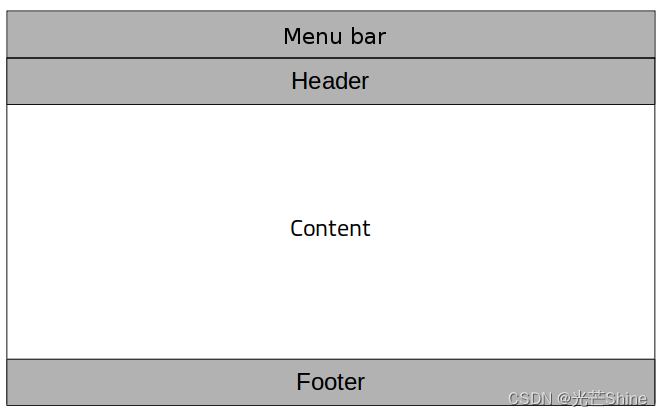
import QtQuick.Controls 2.12
ApplicationWindow {
visible: true
menuBar: MenuBar {
// ...
}
header: ToolBar {
// ...
}
footer: TabBar {
// ...
}
StackView {
anchors.fill: parent
}
}
示例二
使用也是很简单的,其实就利用上面的框架,我们可以选择性的显示 menuBar、header、footer、或者内容区域的。
如果不需要使用对应的控件部分的话,就可以不用写这部分内容的。
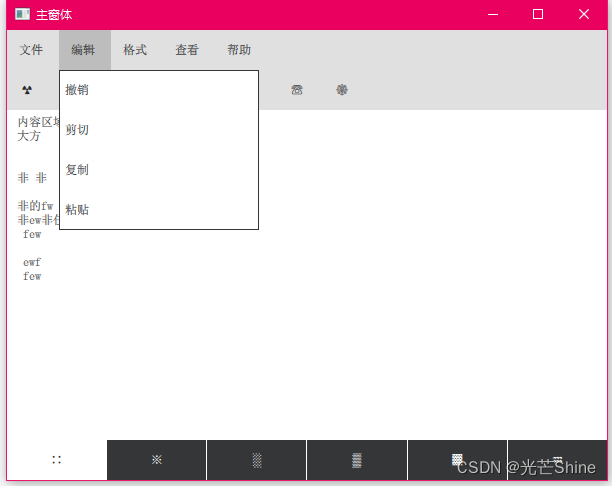
import QtQuick 2.12
import QtQuick.Window 2.12
import QtQuick.Layouts 1.3
import QtQuick.Controls 2.5
ApplicationWindow {
visible: true
width: 600
height: 400
title: "主窗体"
menuBar: MenuBar {
// ...
Menu{
title: "文件"
MenuItem{
text: "新建"
}
MenuItem{
text: "保存"
}
MenuItem{
text: "另存"
}
MenuItem{
text: "关闭"
}
}
Menu{
title: "编辑"
MenuItem{
text: "撤销"
}
MenuItem{
text: "剪切"
}
MenuItem{
text: "复制"
}
MenuItem{
text: "粘贴"
}
}
Menu{
title: "格式"
MenuItem{
text: "自动换行"
}
MenuItem{
text: "字体"
}
}
Menu{
title: "查看"
MenuItem{
text: "缩放"
}
MenuItem{
text: "状态栏"
}
}
Menu{
title: "帮助"
MenuItem{
text: "查看帮助"
}
MenuItem{
text: "发送反馈"
}
MenuItem{
text: "关于记事本"
}
}
}
header: ToolBar {
RowLayout
{
ToolButton
{
text: "?"
}
ToolButton
{
text: "?"
}
ToolButton
{
text: "?"
}
ToolButton
{
text: "?"
}
ToolButton
{
text: "?"
}
ToolButton
{
text: "?"
}
ToolButton
{
text: "?"
}
ToolButton
{
text: "?"
}
}
// ...
}
footer: TabBar {
// ...
TabButton{
text: "∷"
}
TabButton{
text: "※"
}
TabButton{
text: "?"
}
TabButton{
text: "?"
}
TabButton{
text: "▓"
}
TabButton{
text: "?"
}
}
StackView {
anchors.fill: parent
ScrollView{
anchors.fill: parent
TextArea{
text: "内容区域
大方
非 非
非的fw
非ew非任务分为
few
ewf
few
非二维few非
ew
非
ewfwe非
we非
we非wef ewf ew
非ew
非ewf ewf
few
非ew
非ew 访问"
}
}
}
}
■ Container🏆
Container 提供容器通用功能的抽象基类。
Container是类容器用户界面控件的基本类型,允许动态插入和删除Item。
DialogButtonBox, MenuBar, SwipeView, 和 TabBar 都是继承至这个控件。
例子一 演示了如何将Item动态插入TabBar,这是Container的具体实现之一。
Row {
TabBar {
id: tabBar
currentIndex: 0
width: parent.width - addButton.width
TabButton { text: "TabButton" }
}
Component {
id: tabButton
TabButton { text: "TabButton" }
}
Button {
id: addButton
text: "+"
flat: true
onClicked: {
tabBar.addItem(tabButton.createObject(tabBar))
console.log("added:", tabBar.itemAt(tabBar.count - 1))
}
}
}
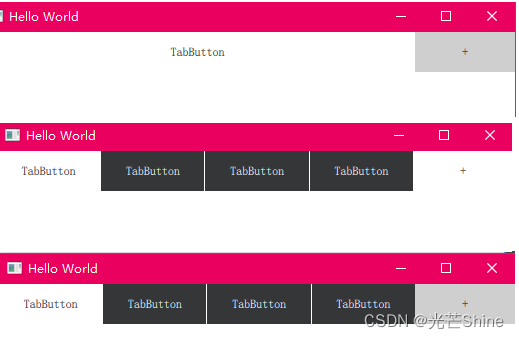
示例二:管理当前索引
当使用多个容器时,例如TabBar和SwipeView,它们的currentIndex属性可以相互绑定以保持它们同步。当用户与任何容器交互时,其当前索引的更改自动传播到另一个容器。
- incrementCurrentIndex ()
- decrementCurrentIndex ()
- setCurrentIndex ()
TabBar {
id: tabBar
currentIndex: swipeView.currentIndex
}
SwipeView {
id: swipeView
currentIndex: tabBar.currentIndex
}
Button {
text: qsTr("Home")
onClicked: swipeView.setCurrentIndex(0)
enabled: swipeView.currentIndex != 0
}
Button {
text: qsTr("Previous")
onClicked: swipeView.decrementCurrentIndex()
enabled: swipeView.currentIndex > 0
}
Button {
text: qsTr("Next")
onClicked: swipeView.incrementCurrentIndex()
enabled: swipeView.currentIndex < swipeView.count - 1
}
示例三:容器实现
Container不提供任何默认的可视化。它用于实现SwipeView和TabBar等容器。在实现自定义容器时,API中最重要的部分是contentModel,它提供了包含的项目,可以用作项目视图和重复器的委托模型。
Container {
id: container
contentItem: ListView {
model: container.contentModel
snapMode: ListView.SnapOneItem
orientation: ListView.Horizontal
}
Text {
text: "Page 1"
width: container.width
height: container.height
}
Text {
text: "Page 2"
width: container.width
height: container.height
}
}
■ Frame🏆
可视 Frame 中布局一组逻辑控件。这个也是一个内容容器,提供了一个边框,但Frame不提供自己的布局。
示例一:
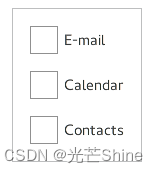
Frame {
ColumnLayout {
anchors.fill: parent
CheckBox { text: qsTr("E-mail") }
CheckBox { text: qsTr("Calendar") }
CheckBox { text: qsTr("Contacts") }
}
}
示例二:定制化

import QtQuick 2.12
import QtQuick.Controls 2.12
Frame {
background: Rectangle {
color: "transparent"
border.color: "#21be2b"
radius: 2
}
Label {
text: qsTr("Content goes here!")
}
}
■ GroupBox🏆
GroupBox用于在一个有标题的可视容器中去布局一组逻辑控件组。GroupBox不提供自己的布局

GroupBox {
title: qsTr("Synchronize")
ColumnLayout {
anchors.fill: parent
CheckBox { text: qsTr("E-mail") }
CheckBox { text: qsTr("Calendar") }
CheckBox { text: qsTr("Contacts") }
}
}
import QtQuick 2.12
import QtQuick.Controls 2.12
GroupBox {
id: control
title: qsTr("GroupBox")
background: Rectangle {
y: control.topPadding - control.bottomPadding
width: parent.width
height: parent.height - control.topPadding + control.bottomPadding
color: "transparent"
border.color: "#21be2b"
radius: 2
}
label: Label {
x: control.leftPadding
width: control.availableWidth
text: control.title
color: "#21be2b"
elide: Text.ElideRight
}
Label {
text: qsTr("Content goes here!")
}
}
■ Page🏆
■ Pane🏆
Pane提供与应用程序样式和主题匹配的背景颜色。Pane不提供自己的布局
示例一:
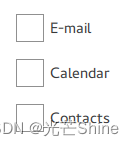
Pane {
ColumnLayout {
anchors.fill: parent
CheckBox { text: qsTr("E-mail") }
CheckBox { text: qsTr("Calendar") }
CheckBox { text: qsTr("Contacts") }
}
}
■ ScrollView🏆
ScrollView 为用户定义的内容提供滚动功能。
示例一:
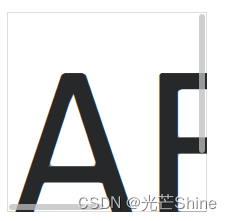
ScrollView {
width: 400
height: 200
clip: true
Column{
Label {
text: "ABC"
font.pixelSize: 224
}
Label {
text: "ABC"
font.pixelSize: 224
}
}
}
显式地将interactive属性设置为true或false,滚动条可以在触摸时实现交互,也可以在与鼠标设备交互时实现非交互。
ScrollView {
// ...
ScrollBar.horizontal.interactive: true
ScrollBar.vertical.interactive: true
}
■ SplitView 🏆
SplitView是一个水平或垂直布局元素的控件,每个元素之间有一个可拖动的分配页面内容的滑块。很像IDE里面的那些窗口。就像下面的简单的布局内容一样。
示例一:
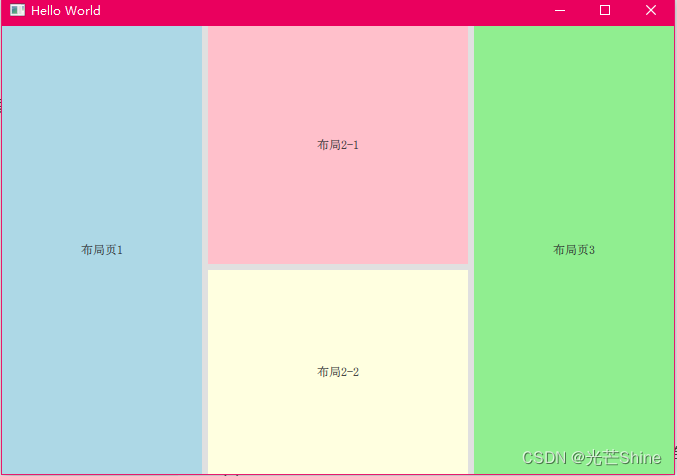
手动调整后:
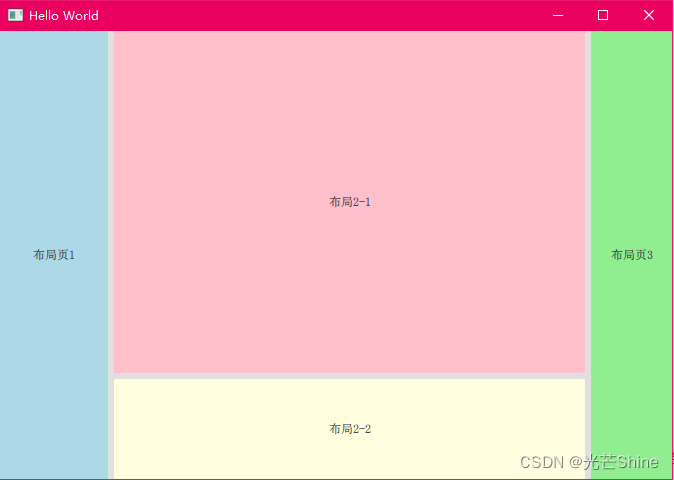
import QtQuick 2.0
import QtQuick.Controls 2.14
import QtQuick.Window 2.12
import QtQuick.Layouts 1.3
import QtQuick.Controls 2.5
Window {
visible: true
width: 640
height: 480
title: qsTr("Hello World")
SplitView {
anchors.fill: parent
orientation: Qt.Horizontal
Rectangle {
implicitWidth: 200
SplitView.maximumWidth: 400
color: "lightblue"
Label {
text: "布局页1"
anchors.centerIn: parent
}
}
SplitView{
SplitView.minimumWidth: 50
SplitView.fillWidth: true
orientation: Qt.Vertical
Rectangle{
color: "pink"
SplitView.minimumHeight: 200
SplitView.fillWidth: true
Label{
anchors.centerIn: parent
text: "布局2-1"
}
}
Rectangle{
color: "lightyellow"
SplitView.minimumHeight: 100
SplitView.fillWidth: true
Label{
anchors.centerIn: parent
text: "布局2-2"
}
}
}
Rectangle {
implicitWidth: 200
color: "lightgreen"
Label {
text: "布局页3"
anchors.centerIn: parent
}
}
}
}
■ StackView 🏆
StackView支持三种主要的导航操作:push()、pop()和replace()。
“push”操作将一个元素添加到栈顶
“pop”操作将栈顶的元素删除
“replace”操作类似于先弹出后推操作,即用新元素替换最上面的元素。栈中最顶层的元素对应于屏幕上当前可见的元素。从逻辑上讲,“push”在应用UI中是向前或更深入的,“pop”是向后导航,而“replace”则是替换当前内容。
示例一:
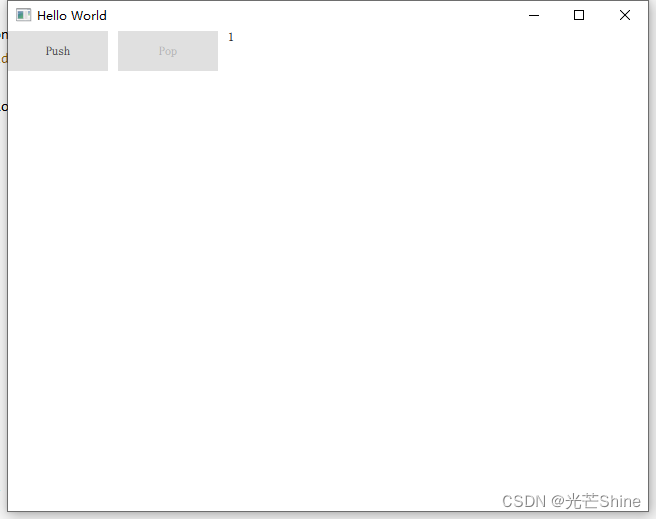
ApplicationWindow {
title: qsTr("Hello World")
width: 640
height: 480
visible: true
StackView {
id: stack
initialItem: mainView
anchors.fill: parent
}
Component {
id: mainView
Row {
spacing: 10
Button {
text: "Push"
onClicked: stack.push(mainView)
}
Button {
text: "Pop"
enabled: stack.depth > 1
onClicked: stack.pop()
}
Text {
text: stack.depth
}
}
}
}
■ SwipeView
SwipeView提供了一个基于滑动的导航模型
SwipeView用一组页面填充。一次只能看到一页。用户可以通过横向滑动在页面之间导航。请注意,SwipeView本身是完全非视觉的。建议将其与PageIndicator结合使用,给用户一个有多个页面的视觉线索。
示例一:
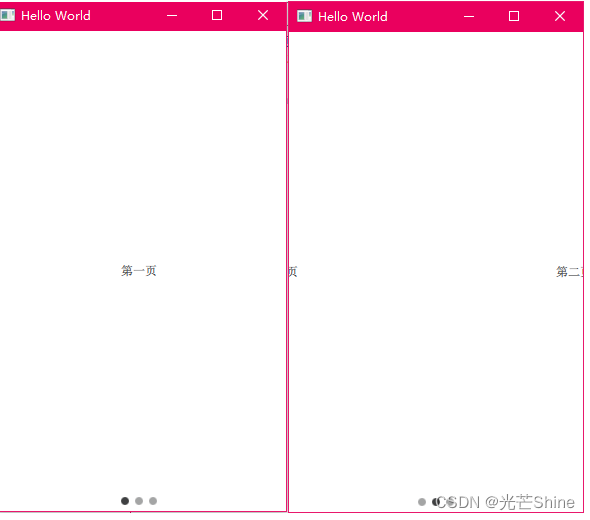
import QtQuick 2.12
import QtQuick.Window 2.12
import QtQuick.Layouts 1.3
import QtQuick.Controls 2.5
Window {
visible: true
width: 640
height: 480
title: qsTr("Hello World")
SwipeView {
id: view
currentIndex: 1
anchors.fill: parent
Item {
id: firstPage
Label{
text: "第一页"
anchors.centerIn: parent
}
}
Item {
id: secondPage
Label{
text: "第二页"
anchors.centerIn: parent
}
}
Item {
id: thirdPage
Label{
text: "第三页"
anchors.centerIn: parent
}
}
}
PageIndicator {
id: indicator
count: view.count
currentIndex: view.currentIndex
anchors.bottom: view.bottom
anchors.horizontalCenter: parent.horizontalCenter
}
}
■ TabBar
TabBar其实就是选项卡,TabBar是由TabButton控件填充,TabBar可以与任何提供currentIndex属性的布局或容器控件一起使用,如StackLayout或SwipeView。
示例一:
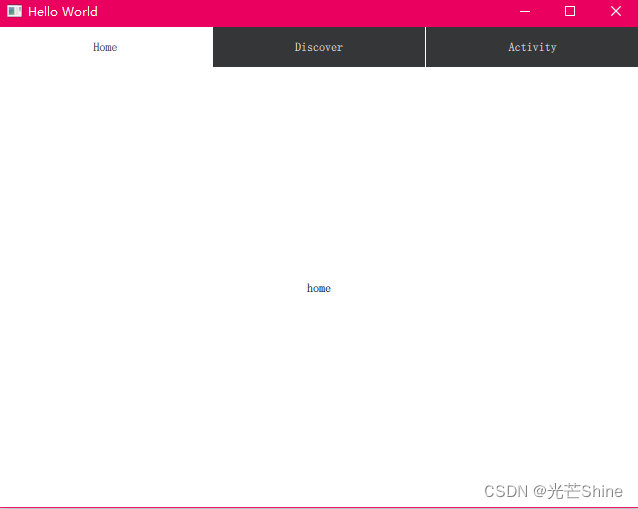
import QtQuick 2.12
import QtQuick.Window 2.12
import QtQuick.Layouts 1.3
import QtQuick.Controls 2.5
Window {
visible: true
width: 640
height: 480
title: qsTr("Hello World")
TabBar {
id: bar
width: parent.width
TabButton {
text: qsTr("Home")
}
TabButton {
text: qsTr("Discover")
}
TabButton {
text: qsTr("Activity")
}
}
StackLayout {
id:stackLayout
anchors.topMargin: 41
anchors.fill: parent
currentIndex: bar.currentIndex
Item {
id: homeTab
Text {
id: homeLabel
x: 308
y: 196
text: qsTr("home")
anchors.verticalCenter: parent.verticalCenter
anchors.horizontalCenter: parent.horizontalCenter
}
}
Item {
id: discoverTab
Text {
id: discoverLabel
x: 308
y: 196
text: qsTr("discover")
anchors.verticalCenter: parent.verticalCenter
anchors.horizontalCenter: parent.horizontalCenter
}
}
Item {
id: activityTab
Text {
id: activityLabel
x: 308
y: 196
text: qsTr("activity")
anchors.verticalCenter: parent.verticalCenter
anchors.horizontalCenter: parent.horizontalCenter
}
}
}
}
■ ToolBar
ToolBar是应用程序范围内和上下文里面便捷的操作和控件的容器,例如导航按钮和搜索字段。其实本质上就是一个装东西的容器。
示例一:

ApplicationWindow {
visible:true
header: ToolBar {
RowLayout {
anchors.fill: parent
ToolButton {
text: qsTr("?")
onClicked: stack.pop()
}
Label {
text: "Title"
elide: Label.ElideRight
horizontalAlignment: Qt.AlignHCenter
verticalAlignment: Qt.AlignVCenter
Layout.fillWidth: true
}
ToolButton {
text: qsTr("?")
onClicked: menu.open()
}
}
}
StackView {
id: stack
anchors.fill: parent
}
}
示例二:

ToolBar {
id: control
background: Rectangle {
implicitHeight: 40
color: "#eeeeee"
Rectangle {
width: parent.width
height: 1
anchors.bottom: parent.bottom
color: "transparent"
border.color: "#21be2b"
}
}
RowLayout {
anchors.fill: parent
ToolButton {
text: qsTr("Undo")
}
ToolButton {
text: qsTr("Redo")
}
}
}
本文来自互联网用户投稿,该文观点仅代表作者本人,不代表本站立场。本站仅提供信息存储空间服务,不拥有所有权,不承担相关法律责任。 如若内容造成侵权/违法违规/事实不符,请联系我的编程经验分享网邮箱:chenni525@qq.com进行投诉反馈,一经查实,立即删除!
- Python教程
- 深入理解 MySQL 中的 HAVING 关键字和聚合函数
- Qt之QChar编码(1)
- MyBatis入门基础篇
- 用Python脚本实现FFmpeg批量转换
- 一题多解求1+(1+2)+(1+2+3)+......+(1+2+3+4+5+......+n)
- 探索C语言中的水仙花数及其计算方法
- leetcode 75. 颜色分类(medium)(优质解法)
- 走进Spring Boot 3.x时代(一)
- 直播江湖:东方甄选与董宇辉的权力游戏
- Megatron-LM源码系列(六):Distributed-Optimizer分布式优化器实现Part1
- 吃瓜教程Task1:概览西瓜书+南瓜书第1、2章
- 带您了解目前AI在测试领域能够解决的那些问题
- 接口自动化测试问题汇总
- 在Gitee上维护Erpnext源